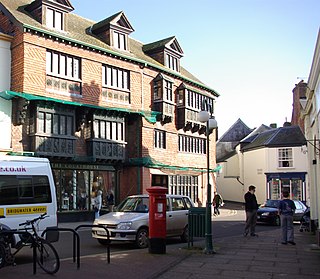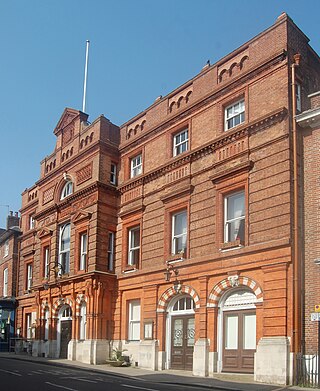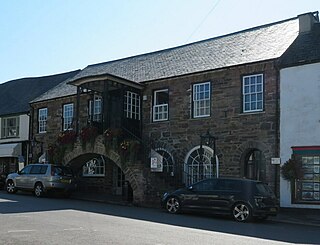
Taunton is the county town of Somerset, England. It is a market town and has a minster church. Its population in 2011 was 64,621. Its thousand-year history includes a 10th-century monastic foundation, owned by the Bishops of Winchester, which was rebuilt as Taunton Castle by the Normans in the 12th century. Parts of the inner ward house were turned into the Museum of Somerset and Somerset Military Museum. For the Second Cornish uprising of 1497, Perkin Warbeck brought an army of 6,000; most surrendered to Henry VII on 4 October 1497. On 20 June 1685 in Taunton the Duke of Monmouth crowned himself King of England in a rebellion, defeated at the Battle of Sedgemoor. Judge Jeffreys led the Bloody Assizes in the Castle's Great Hall.

Wellington is a market town in Somerset, England. It is situated 7 miles (11 km) south west of Taunton, near the border with Devon, which runs along the Blackdown Hills to the south of the town. The town had a population of 16,669, which includes the residents of the parish of Wellington Without, and the villages of Tone and Tonedale.

Wiveliscombe is a town and civil parish in Somerset, England, situated 9 miles (14 km) west of Taunton. The town has a population of 2,893. The Square, fronted by several listed structures, held the former market. The parish includes the nearby hamlet of Maundown.

The Municipal Buildings are historic buildings in Corporation Street, Taunton, Somerset, England. The buildings, which were the home of Taunton Grammar School before becoming the headquarters of Taunton Borough Council, are Grade II* listed.

The Crescent is a street in Taunton, a town in the English county of Somerset. Construction began in 1807, during a period of extensive redevelopment in the town, driven by the Market House Society and the Member of Parliament Sir Benjamin Hammet. Lined on the eastern side by a Georgian terrace, the street follows a shallow crescent shape, broken in the middle by Crescent Way and a bit further south by St George's Place. It links Upper High Street, at its southern end, with Park Street and Tower Street to the north. On the western side, Somerset County Council have their offices in the County Hall, erected in 1935, and extended in the 1960s. The Georgian terrace, the Masonic Hall, and the County Hall are recorded in the National Heritage List for England as listed buildings.

Chorley Town Hall is a municipal building in Market Street in Chorley, Lancashire, England.

Folkestone Town Hall, also known as The Guildhall, is a municipal building in Guildhall Street, Folkestone, Kent, England. The town hall serves as the headquarters of Folkestone Town Council, and also houses the Folkestone Museum. It is a Grade II listed building.

Bridgwater Town Hall is a municipal building in the High Street, Bridgwater, Somerset, England. The town hall, which was the headquarters of Bridgwater Borough Council, is a Grade II listed building.

Lewes Town Hall is a municipal building in the High Street in Lewes, East Sussex, England. The structure, which is the meeting place of Lewes Town Council, is a Grade II listed building.

Buckingham Town Hall is a municipal building in the Market Square, Buckingham, Buckinghamshire, England. The structure, which was the meeting place of Buckingham Borough Council, is a Grade II* listed building.

Blandford Forum Town Hall is a municipal building in the Market Place in Blandford Forum, Dorset, England. The 18th-century structure, which was the meeting place of Blandford Forum Borough Council, is a Grade I listed building.

Minehead Town Hall is a municipal building in The Parade, Minehead, Somerset, England. The structure, which is the meeting place of Minehead Town Council, is a Grade II listed building.

Liskeard Guildhall is a municipal building in Pike Street, Liskeard, Cornwall, England. The structure, which was the meeting place of Liskeard Borough Council, is a Grade II* listed building.

Holyhead Town Hall is a municipal structure in Newry Street, Holyhead, Wales. The town hall is the meeting place of Holyhead Town Council.

Stonehaven Town Hall is a municipal building in Allardice Street, Stonehaven, Aberdeenshire, Scotland. The building, which is largely used as an events venue, is a Category B listed building.

Glastonbury Town Hall is a municipal building in Magdalene Street, Glastonbury, Somerset, England. The structure, which is the meeting place of Glastonbury Town Council, is a Grade II* listed building.

Kingsbridge Town Hall is a municipal building in Fore Street, Kingsbridge, Devon, England. The town hall, which is currently used as a cinema, is a Grade II listed building.

Dulverton Town Hall is a municipal building in Fore Street in Dulverton, Somerset, England. The building, which is the meeting place of Dulverton Town Council, is a Grade II listed building.

Pwllheli Town Hall is a municipal building in Penlan Street, Pwllheli, Gwynedd, Wales. The structure, which now operates as an arts centre, is a Grade II listed building.

Tenby Town Hall is a municipal building in the High Street, Tenby, Pembrokeshire, Wales. The structure, which is used as an events venue, is a Grade II listed building.





















